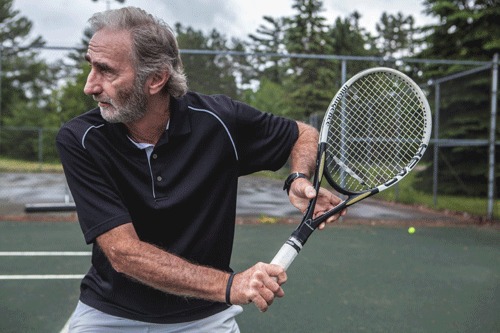TENNIS TIPS: The one-handed backhand: Alive and well?

Photo by Shaun Ondak Jak Beardsworth demonstrates the starting position for a one-handed backhand.
At this year’s French Open men’s round of 16 half the players sported one-handed backhands. Does this mean it’s still alive and well in today’s pro game? Has it managed to survive the four decade long two-handed onslaught initiated by Jimmy, Chrissie, and Bjorn back when?
Not really.
Even the one-handed maestro himself, Roger Federer, agrees, albeit with a hint of reluctance, probably not wanting to think about the fact that he was ultimately supplanted as the world No. 1 by Rafael Nadal, specifically because of Nadal’s lethal lefty topspin forehand cross court up high to the Fed one-hander.
The USTA’s scaled down mandate for kid’s tennis – smartly modeled after little league baseball with its smaller fields, lighter bats and softer balls – is fully supported by its industry partners including club pros. This means, the one-hander really should be alive and well with the super lightweight mini-rackets and the age varying low bounce spongy balls that eliminate the previously demanding physical task of the one-hander. Regulation heavier balls bounce unforgivingly up and right through kids’ strike zones.
Previously, as children began playing at a younger and younger age, a 26-inch racket (27 inches is the standard length) was the only alternative. It was a marginally scaled down version of a conventional stick. Although somewhat more maneuverable, it was still an unwieldy club for still developing, smaller youngsters compared to what’s available today.
No wonder an entire generation, spurred on by its coaches, embraced the two-hander to offset the more physically challenging and longer learning curve one-hander.
But the Nadal forehand ferocity won’t be at a club near you anytime soon. So, with today’s lightweight, powerful equipment, the challenge of the one-hander is no longer daunting for any age. Now it’s just a matter of committing, for both those new to the game and its long termers – who have mostly favored the one-hander for years – to really learn its nuanced technique for it not to be a liability as is too often the case.
In the photo you can see that I’ve already changed my grip and have coiled-up in one motion preparing to take an aggressive one-handed backhand cut. My right shoulder and chin are in close proximity to insure a sideways, fully turned hitting position, while the left hand – the “off-hand” – has drawn the racket back positioned around its throat. Yes, it takes two hands to hit an effective one-handed backhand.
The racket face is slightly open since I’m going to drive the ball with considerable underspin pace that will skid the ball quickly through the court upon bouncing – otherwise known as “the knife.” Opponents do not like this in clubland, and on tour as well at times. It’s a rhythm buster, especially disrupting since it’s in such marked contrast to the higher bouncing topspin typically generated off the forehand wing.
To maintain balance and facilitate racket speed through the impact zone, the left hand remains back as an anchor and stays back during the follow through.Because you’re reaching across your body, the trunk rotation so prevalent on any forehand or two-handed backhand is a no-no. That difference is defining.
More than anything, staying sideways through the shot, and keeping the ball in front, will make you and your improved one-hander famous by next Thursday.
—
Do your best. Always aspire higher. Love the game.
Jak Beardsworth, USPTA Elite Pro, is available for lessons at the Crowne Plaza-Lake Placid Club. JB1tennis@comcast.net, 941-626-0097, www.JakBeardsworthTennis.com.





